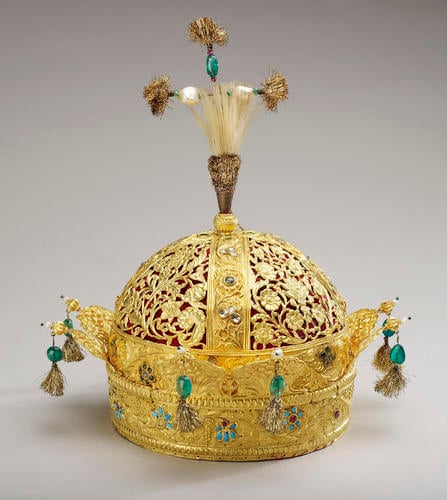-
1 of 253523 objects
Crown of the Emperor Bahadur Shah II second quarter 19th century
Gold, turquoises, rubies, diamonds, pearls, emeralds, feathers and velvet | 28.5 x 23.5 x 23.5 cm (whole object) | RCIN 67236
-
In the aftermath of the Indian Uprising of 1857, Bahadur Shah (1775-1862), nominally the last Mughal emperor and King of Delhi, was deposed and exiled to Burma, and the involvement of the East India Company in the government of India ceased. The official end of the Mughal Empire was marked in Delhi by the auction of quantities of jewels and other valuable relics of Bahadur Shah’s court.
Three such relics, the Emperor’s crown and two throne chairs, were bought by Major Robert Tytler (1818-72) of the 38th Regiment of Native Infantry (Bengal), who had taken part in the Siege of Delhi. Returning to England in 1860 Tytler declined £1,000 for the crown from a Bond Street jeweller, deciding instead to offer the relics to Queen Victoria. On 3 January 1861, Sir Charles Wood (1800-1885; later Viscount Halifax), Secretary of State for India, wrote to Prince Albert from the India Office, enclosed a memorandum regarding Tytler’s relics, mentioning in particular ‘an article of head dress which has been brought here … It cannot however be called a crown. It is a very rich skull-cap worn on the head of the Emperor, & round the lower part of which the turban was wound - & in the turban jewels were placed.’ Sir Charles recorded that Sir John Lawrence (1811-79, a member of the Council of India and later Viceroy) had seen the crown ‘& has no doubt of its being what the Emperor actually wore’. In response, the Prince (who immediately recognised the great symbolic value and historical interest of the relics) asked Sir Charles to find out what the owner expected for the crown and for the two throne chairs that were also mentioned. On 8 January Wood reported to the Prince that the crown had been sent to Windsor for the Queen to inspect. Both the crown and the throne chairs were subsequently purchased by the Queen.
As recounted in later years by his wife, Tytler felt that the figure of £500 offered by Sir Charles for the crown and two throne chairs was far too low, but reluctantly agreed to it on the promise of a suitable appointment when he returned to India. No such appointment was forthcoming, and the unsatisfactory nature of the transaction with Sir Charles continued to rankle with Harriet Tytler when writing her memoirs more than forty years later.
Text adapted from Victoria & Albert: Art & Love, London, 2010Provenance
Purchased by Queen Victoria, 1861
-
Creator(s)
(nationality)Acquirer(s)
-
Medium and techniques
Gold, turquoises, rubies, diamonds, pearls, emeralds, feathers and velvet
Measurements
28.5 x 23.5 x 23.5 cm (whole object)
Alternative title(s)
The King of Delhi, Bahadoor Shah Crown
Place of Production
India
